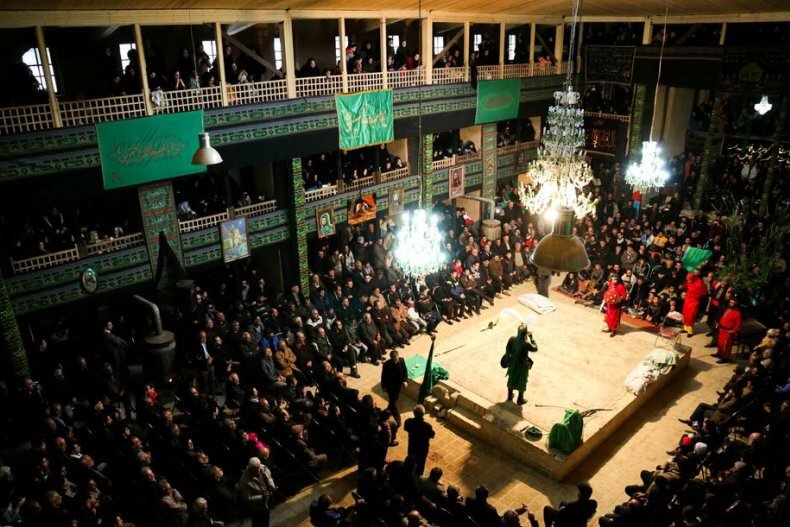Tekyehs, venues for the gathering of mourners who honor the way Imam Hussein (AS) chose to live and to die, have been blood floating in the Iranian mourning culture veins, refreshed year after year, century after century, since Iranians have mourned the martyrdom anniversary of Imam Hussein (AS), the grandson of Prophet Muhammad (PBUH) and his 72 loyal companions for centuries.
The round stages of tekyehs have been a place for eulogists who lead the mourners to beat on their chests according to the rhythm of a sung eulogy, a rendezvous for those who are wailing over an old but still bleeding wound, as well as a stage for performing tazieh, Iranian passion play, inspired by historical and religious narrations, reviving the story and the pain over and over again.
The horses’ whinnies, the clanging of the swords along with men in war clothes as well as the sound of the crying women who are watching the play from the balconies, remind the audience of the events on Ashura, the 10th day of Muharram, the day upon which Imam Hussein (AS) and his companions were martyred in Karbala in 680 CE.
The beginning of the Muharram rituals in Islamic countries and Iran can be traced back to the Buyid dynasty (945–1055), however after centuries, during the Safavid era (1501–1736) that a religious government was established, such ceremonies were practiced more seriously.
While Tekyehs had different uses, they faced various changes over time and gradually they have become places for holding mourning ceremonies especially during the lunar month of Muharram. They have been able to bridge the gap between people from different walks of life with Ashura culture and have tried to keep this culture alive and unforgettable through history.
During the Qajar era (1789–1925) new styles and methods in the mourning ceremonies were created and the ceremonies became more thriving, making tekyehs more popular.
However, in the early Pahlavi period (1925-1979), by order of Reza Shah, religious mourning ceremonies were banned and tekyehs were closed. This was the time places such as mosques, shrines and even gardens and corners of the yards of people’s houses became small tekyehs and these places played a vital role in keeping alive and promoting such ceremonies.
Nowadays, after almost one century, during Muharram, apart from mosques, each neighborhood sets up its own tekyeh for gathering of mourners known as ‘heyat’ (literally meaning group or delegation) and the ceremonial processions of the month.
Participating in mourning ceremonies was a large part of people’s lives in old Tehran as well as other central cities across the country. About 150 years ago, Tehran had between 50 and 70 local tekyehs, which are now destroyed or replaced by hosayniyas (places used for religious mourning ceremonies).
Today tekyehs, however, are specific locations for mourners who meet and participate in religious gathering after which they head out on the streets in groups known as dasteh (literally meaning cluster) to parade dramatic mourning.
Tekyeh Dowlat, one of the icons of ancient Tehran, is the most well-known tekyeh in Iran, while Tekyeh Khanum seems to be the oldest one.
Being completed in 1868 by the order of Naser al-Din Shah Qajar, Tekyeh Dowlat, literally meaning “State Theater”, was one of the most famous of all the tazieh performance spaces in the country. It has a capacity for more than 4,000 people.
It is said that American statesman Samuel Greene Wheeler Benjamin believed that Tekyeh Dowlat was comparable to Verona Arena, a Roman amphitheater in Piazza Bra in Verona, Italy.
Tekyeh Khanum was built by the order of the sister of Tahmasp I, one of the Safavid kings. When the king was developing Tehran, his sister was constructing a school, a public bathhouse along with the tekyeh, which are all known as Khanum buildings.
Tekyehs and holding Muharram rituals have kept the story of Ashura alive over the years. Apart from mourning, holding these ceremonies have affected art and architecture as well as drama and literature, and are now an important part of people’s lives.


No comments:
Post a Comment